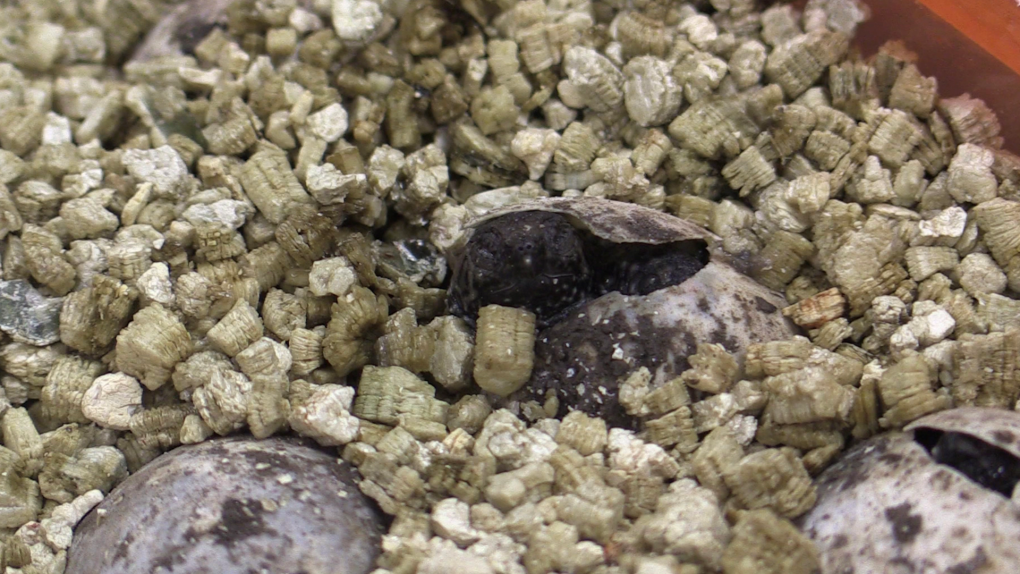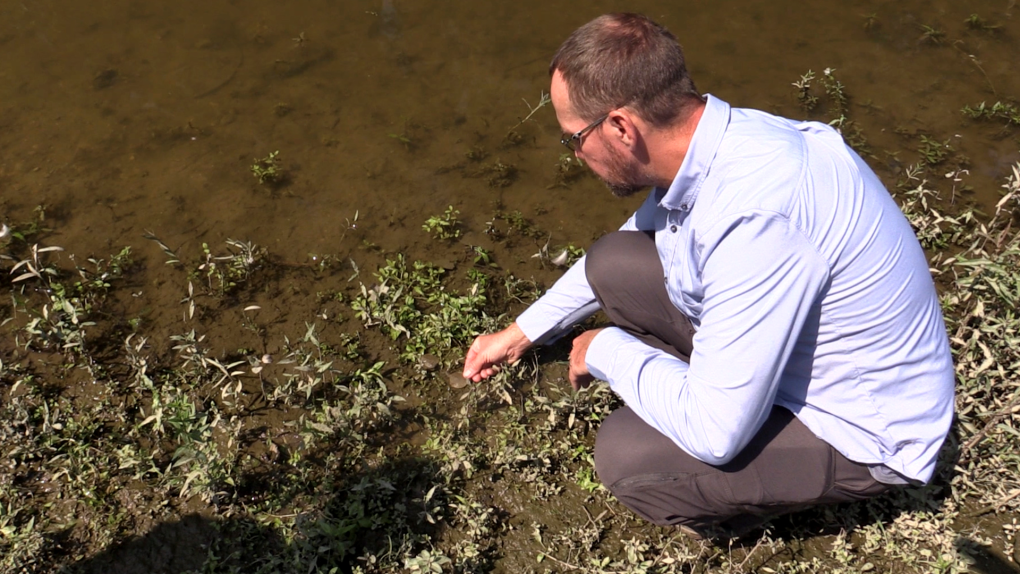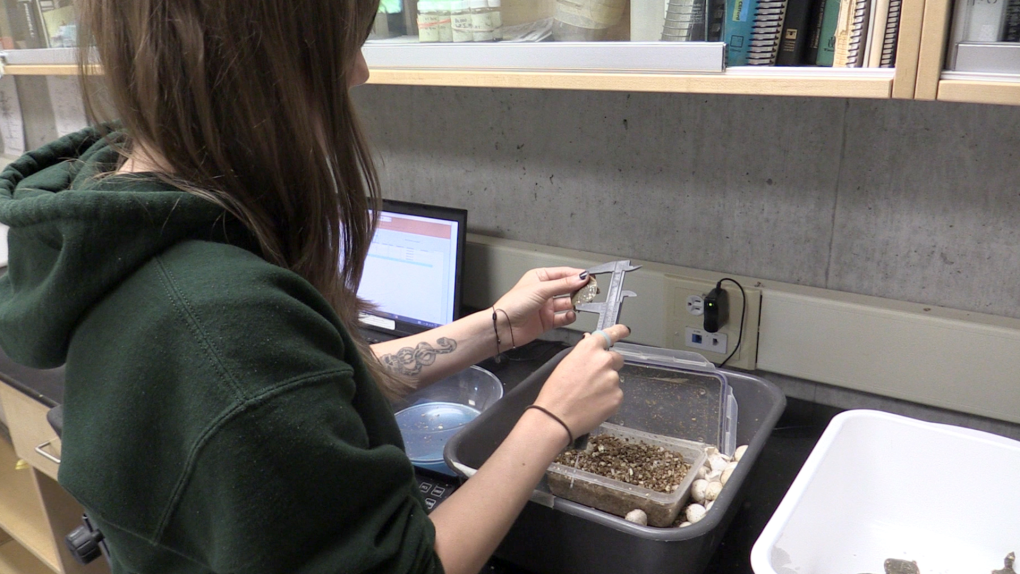'The grand finale': 10,000 endangered baby turtles released back into river
Scott Gillingwater has dedicated his life to protecting at-risk species.
For 30 years, the biologist at the Upper Thames River Conservation Authority (UTRCA) has been saving, incubating, and releasing 10,000 turtle hatchlings of seven species back into the wild.
“[Tuesday] is the grand finale of all the work we’ve done this year,” said Gillingwater, as he and his team were putting endangered turtles back into the river. “It's always exciting for myself, for the crew, to be able to kind of see this thing full circle.”
Two months ago, the ‘Turtle Team’ began collecting eggs daily from the wild and bringing them into the Southern Ontario At Risk Reptiles (SOARR) lab in London, Ont.
“Once they hatch out, they'll go into bins with water and vegetation and that just keeps them calm,” said Sean Thorpe, a three-year member of the ‘Turtle Team’.
A few feet away in the lab, Amanda Farrell began recording data from the hatchlings.
Some days they’ll be released right away back where they came from. Others may stay in the lab for a few days.
 A baby turtle poked its way out of an egg as it started to hatch in a lab at the Upper Thames River Conservation Authority on August 29, 2023. (Brent Lale/CTV News London)
A baby turtle poked its way out of an egg as it started to hatch in a lab at the Upper Thames River Conservation Authority on August 29, 2023. (Brent Lale/CTV News London)
“The spiny softshell turtle is endangered, so we actually weigh and measure those ones as well,” said Farrell, a first-year wildlife assistant. “We input it into our computer, so in future years we can see the progress that we've made.”
Then it’s time for the difficult and satisfying part of letting them go.
“Every single turtle that hatches you talk to,” said Thorpe. “When you go to release them, you also talk to them because you've been with them the whole way from when they were put into the ground to when they go back out.”
 Biologist Scott Gillingwater of the Upper Thames River Conservation Authority released an endangered baby turtle back into the wild on August 29, 2023. (Brent Lale/CTV News London)
Biologist Scott Gillingwater of the Upper Thames River Conservation Authority released an endangered baby turtle back into the wild on August 29, 2023. (Brent Lale/CTV News London)
After three decades, Gillingwater feels the same. He’s been locating and studying the largest known populations of threatened and endangered reptiles, including the Spiny Softshell Turtle, Blanding’s Turtle, Spotted Turtle, Queensnake, and others.
Now that the reptiles are past the most dangerous and vulnerable stage, it’s a long journey of survival.
“Now they're on their own, it may take 12 to 15 years to reach maturity,’ said Gillingwater. “We wish them luck. Maybe only one to 10 per cent will survive, but if we put enough into the environment, we will ensure that some reached maturity and can reproduce long into the future.”
 Wildlife assistant Amanda Farrell measured a baby turtle in the lab at the Upper Thames River Conservation Authority on August 29, 2023. (Brent Lale/CTV News London)
Wildlife assistant Amanda Farrell measured a baby turtle in the lab at the Upper Thames River Conservation Authority on August 29, 2023. (Brent Lale/CTV News London)
CTVNews.ca Top Stories

2 Canadians confirmed dead in Poland, as consular officials gather information
Two Canadians have died following an incident in Poland, CTV News has learned.
Downtown Vancouver stabbing suspect dead after being shot by police
A suspect is dead after being shot by police in a Vancouver convenience store after two people were injured in a stabbing Wednesday morning, according to authorities.
DEVELOPING As police search for suspect, disturbing video surfaces after U.S. health-care CEO gunned down in New York
UnitedHealthcare CEO Brian Thompson was killed Wednesday morning in what investigators suspect was a targeted shooting outside a Manhattan hotel where the health insurer was holding an investor conference.
'Utterly absurd': Freeland rebuffs Poilievre's offer of two hours to present fall economic statement
Deputy Prime Minister and Finance Minister Chrystia Freeland has rebuffed Conservative Leader Pierre Poilievre's offer to give up two hours of scheduled opposition time next Monday to present the awaited fall economic statement as 'utterly absurd.'
Canada Post stores continue to operate during strike — but why?
As many postal workers continue to strike across the country, some Canadians have been puzzled by the fact some Canada Post offices and retail outlets remain open.
Toddler fatally shot after his 7-year-old brother finds a gun in the family's truck
A two-year-old boy was fatally shot when his seven-year-old brother found a gun in the glovebox of the family's truck in Southern California, authorities said.
Ontario Premier Doug Ford calls Donald Trump 'funny guy' in Fox News interview
Ontario Premier Doug Ford called U.S. president-elect Donald Trump a 'funny guy' on Wednesday in an interview with Fox News for his comment that Canada should become the United States's 51st state.
Mattel sued over 'Wicked' dolls with porn website link
Mattel was sued this week by a South Carolina mother for mistakenly putting a link to an adult film site on the packaging for its dolls tied to the movie 'Wicked.'
Transport Minister to summon airline CEOs as Air Canada set to charge carry-on fees for some passengers
Transport Minister Anita Anand says she will be calling Canadian airline CEOs to a meeting in mid-December after Air Canada says it will charge some passengers for carry-on bags in the new year.

































